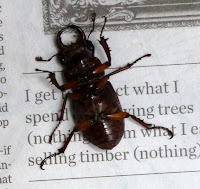 |
| Prairie Guide- Click to enlarge |
Recently Barb, I and a backpack sprayer made our annual trek to hunt Sericea and other invasive species on
La Petite Gemme Prairie. The weather was perfect, 70 degrees at 8:00 in the morning. We were joined initially by a neighboring dog that volunteered to guide us. We headed up the hill, the highest one of the original three that led to the name Three Mound Prairie.
Looking to the east you can see suburban housing of Bolivar. On the western border, cyclists cruise quietly along the
Frisco Highline Trail, developed by
Ozark Greenways. With a squint of your eyes and mind, you can almost hear the Frisco train which took Harry Truman back and forth between Springfield and Bolivar in 1948 as he practiced for what would be his famous whistle stop campaign for president.
While the world has changed, scattered remnants of prairie remain, thanks to organizations such as the
Missouri Prairie Foundation (MPF) which purchased the land in 1974. Under the joint management of MPF and the Missouri Department of Conservation, the prairie remains intact. Surrounded by farm land and lawns, it has so far avoided both the plow, urbanization and fescue monoculture.
This is not to say that it is pristine. Introduced invasive species such as Sericea lespedeza and Japanese honeysuckle constantly crop up, threatening to take over. Without active management including spot spraying herbicides and the use of prescribed fire, exotic invasives and early succession native shrubs and trees such as sassafras and wooly buckthorn would eventually take over. This year we even found some scattered asparagus which had migrated from a neighboring garden.
Walking through the thick knee high vegetation, we didn't have time to look for the copious animal life which was beneath our feet. Beautiful golden dragonflies flitted around us. One landed on a stem, tantalizing me while avoiding the screen of my pocket camera. Only one shot pictured it partially, preserving the memory but not enough for identification. I sent it to Tana Pulles who identified it as a Widow Skimmer. Without a view of the underside of its abdomen, its sex will remain unknown.
The prairie was covered with familiar species such as purple cone flower, rattlesnake master, spiderwort and last week's favorite, sensitive plant. Prairie mimosa
Desmanthus illinoensis was a new species to us, with leaves similar to sensitive plant but no briar-like spine or cute folding leaf tricks. Prairie roses were in full bloom, attracting the first of the Japanese beetle scouts.
 Lead plant
Lead plant was common on the hillside, quite distinctive against the darker green background. Its pale gray hairy leaves look like they were dusted with lead powder. Many mammals eat this nutritious plant as do a diverse range of insects. These in turn feed insectivores, an important ingredient of the food chain. Later this summer it will also produce a stalk of tiny beautiful blossoms, hosting a wide variety of bees.
Blackberries were underfoot everywhere, a blessing this week but a curse for a prairie the rest of the year. They will take over if not controlled, but today they fueled our mission as we consumed a handful whenever we spotted the juicy berries. They also taught me a lesson in greed. Without any other container, we used my hat to collect a supply for home. Unfortunately, the stain of blackberries is resistant to soap and bleach. From now on, they shall know me by my (red-stained) hat.
Like most true gems, prairies like La Petite Gemme are rare, 99.9% having been converted to other habitat. Preserving what we have is like maintaining a museum or zoo, a place to savor a diverse ecosystem that once covered much of the midwest. Like a museum or zoo, a prairie requires our constant maintenance. Consider supporting the
Missouri Prairie Foundation.

















































